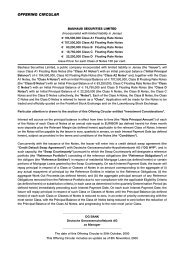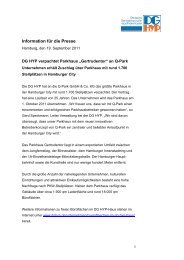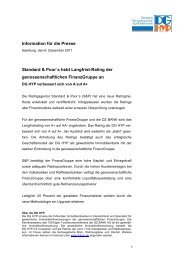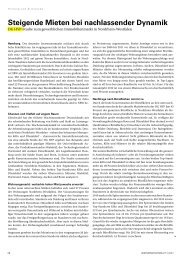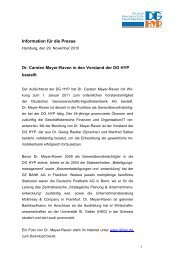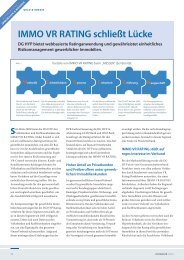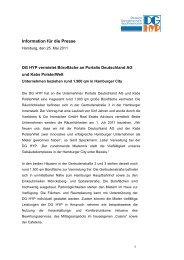ANNUAL REPORT 2008 - DG Hyp
ANNUAL REPORT 2008 - DG Hyp
ANNUAL REPORT 2008 - DG Hyp
Create successful ePaper yourself
Turn your PDF publications into a flip-book with our unique Google optimized e-Paper software.
With regard to capital market products, the existing<br />
portfolio of mortgage backed securities (MBS) is also<br />
looked after centrally in Hamburg by a specialist backoffice<br />
department. New business is not currently being pursued<br />
in this product area in the wake of the global financial<br />
markets crisis.<br />
b) Limit system<br />
<strong>DG</strong> HYP has a limit system in place to manage and<br />
monitor counterparty and country risks. This system calculates<br />
the utilisation of external limits (country risk limits in<br />
the DZ BANK Group, and default risks in accordance with<br />
section 13 of the KWG), setting internal limits for country<br />
and default risks simultaneously and independently of one<br />
another. The respective limits must be upheld and can be<br />
viewed at any time via an online system.<br />
During the back-office monitoring processes, the utilisation<br />
of the individual limits is monitored daily. If the limits<br />
are exceeded a process of escalation is induced, during<br />
which support is provided to ensure that the limit is<br />
returned to, and that suitable measures are implemented.<br />
Internal individual risk limits are identified depending<br />
on the individual counterparty risk of the business partner.<br />
Essentially, this is carried out in cooperation with the parent<br />
company DZ BANK, which calculates an individual VR<br />
rating per counterparty risk and makes this available to<br />
<strong>DG</strong> HYP. Additionally, as part of Group risk management,<br />
limits and ceilings on counterparty risks are taken into<br />
account, whilst an agreed traffic light system for the early<br />
detection of risks is also in place.<br />
c) Credit rating<br />
In order to take the particular demands on the commercial<br />
real estate lending business into account, <strong>DG</strong> HYP<br />
has developed (in cooperation with the central institutions<br />
of the German cooperative banking sector and BVR) and<br />
implemented a special Basel-II compliant rating system for<br />
specialised lending (SLRE – Specialised Lending Real<br />
Estate). These rating procedures apply to the following customer<br />
groups: real estate developers, residential property<br />
developers, development companies, closed-end funds,<br />
project developers and commercial real estate investors.<br />
The procedures underwent end-to-end validation, updates<br />
and optimisation during the period under review. An independent<br />
consultancy company has described the procedures<br />
as ‘state of the art’. Given this particularly high level<br />
of quality, the procedures will therefore also be rolled out<br />
in the cooperative banks in 2009 in the context of a rating<br />
desk solution.<br />
30 Deutsche Genossenschafts-<strong>Hyp</strong>othekenbank AG | Annual Report <strong>2008</strong><br />
Management Report<br />
The calculated data forms the basis for the lending<br />
decision and pricing. The borrower’s rating in conjunction<br />
with the property’s ability to cover interest and principal<br />
repayments, is at the forefront of <strong>DG</strong> HYP’s forward-looking<br />
credit analysis. Also taken into account is the security<br />
situation and, where applicable, any existed intertwining of<br />
risks.<br />
For local authority lending, credit ratings are also estimated<br />
based on a rating method that complies with<br />
Basel II. <strong>DG</strong> HYP played a major role in developing the<br />
municipal rating system, particularly within the scope of a<br />
cooperative project where vdp joined forces with S&P Risk<br />
Solutions. We use the VR rating procedures implemented<br />
in DZ BANK within the framework of a ‘rating desk’ solution<br />
for the rating of sovereigns, banks and key accounts.<br />
As part of the implementation of Basel II, the review of<br />
loan exposure – including a rating update required under<br />
section 18 of the KWG – has been expanded for all customer<br />
categories registered for IRBA. In addition, monitoring<br />
documents are prepared regularly for exposures<br />
exceeding EUR 2.5 million per primary obligor group. The<br />
monitoring comprises the rating analysis and other customer<br />
records, an assessment of the current rental situation,<br />
and the tenant rating(s). The property or other collateral<br />
is revalued if deemed necessary.<br />
d) Management of problem loans<br />
<strong>DG</strong> HYP uses what is known as an individual risk management<br />
system for the purposes of early warning and the<br />
management of problem loans, this being used in a similar<br />
way at the parent company DZ BANK. Cases with early<br />
warning signs of a possible long-term negative development<br />
are assigned to a yellow list. Loans with regard to<br />
which a subsequent loss cannot be excluded are kept on a<br />
watch list. The loans included on this watch list are not<br />
subject to individual write-downs. Where there is clear<br />
negative trend, coupled with an existing requirement for<br />
risk provisioning in the form of individual value adjustments,<br />
the cases are included on the list of individual writedowns.<br />
The processing rules and requirements on the<br />
transfer from one ERM list to another are subject to<br />
defined criteria.<br />
Those problem credit exposures whose economic perspective<br />
can be assessed as positive are processed in the<br />
restructuring department, which forms part of the back<br />
office. Submitting a concept that must comprise a differentiated<br />
analysis and assessment of the overall situation of<br />
the exposure and a cost-benefit analysis, as well as a com-






